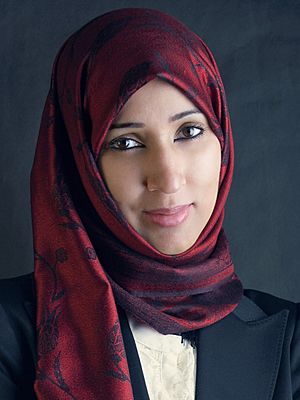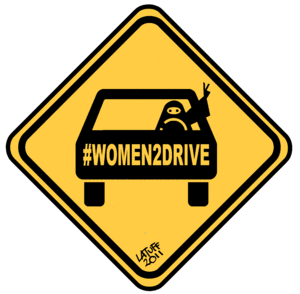Manal al-Sharif facts for kids
Quick facts for kids
Manal al-Sharif
|
|
|---|---|
| منال الشريف | |

Al-Sharif in 2011
|
|
| Born | 25 April 1979 |
| Occupation |
|
| Known for | Defying female driving ban in Saudi Arabia |
| Spouse(s) |
First husband
(divorced)Rafael
(m. 2012) |
| Children | 2 |
Manal al-Sharif (Arabic: منال الشريف, romanized: Manāl Aš-Šarīf; born 25 April 1979) is a brave Saudi Arabian activist. She has worked hard to help women gain more rights in her country. She is especially famous for starting a campaign in 2011 that helped women get the right to drive.
Manal al-Sharif's friend, Wajeha al-Huwaider, filmed her driving a car. This video was shared online on YouTube and Facebook. It quickly became very popular. Manal was arrested for driving, but she was later released. Her actions brought a lot of attention to the issue of women's rights in Saudi Arabia. News organizations like The New York Times saw her campaign as part of a bigger movement for change in the Middle East.
After her driving campaign, Manal al-Sharif continued to speak out. She used social media, like Twitter, to talk about important issues. These included helping foreign workers who were in prison and asking for more fair elections. Her work has been recognized by important magazines and groups around the world.
Contents
Early Life and Career
Manal al-Sharif studied computers at King Abdulaziz University. She earned a degree in computing and also got a special certification for computer networks. For many years, she worked as a computer security expert for Saudi Aramco. This is Saudi Arabia's national oil company. She also wrote articles for a Saudi newspaper called Alhayat.
In June 2017, Manal al-Sharif published her first book. It is called Daring to Drive: a Saudi Woman's Awakening. The book shares her story and her fight for women's rights. It has also been translated into other languages.
Fighting for Women's Rights
Manal al-Sharif has been a champion for women's rights in Saudi Arabia for a long time. She is known for bringing attention to the challenges women face. Amnesty International, a group that works for human rights, praised her efforts. They said she was following in the footsteps of many women activists worldwide. These activists bravely stand up to unfair laws and rules.
Women's Driving Rights in Saudi Arabia
For many years, women in Saudi Arabia had limited freedom to move around. They were not allowed to drive cars on public roads. In 1990, a group of women in Riyadh drove their cars to protest this rule. They were put in prison for a day and had their passports taken away. Some even lost their jobs.
In 2007, a group called the Association for the Protection and Defense of Women's Rights in Saudi Arabia asked the King to allow women to drive. In 2008, Wajeha al-Huwaider filmed herself driving. This video also got a lot of attention around the world. These actions helped set the stage for Manal al-Sharif's campaign.
The 2011 Driving Campaign
In 2011, Manal al-Sharif and other women started a Facebook campaign. It was called "Teach me how to drive so I can protect myself" or "Women2Drive." The campaign asked women to start driving on 17 June 2011. Many people supported the idea. Manal said this was about women's rights, not just a protest. Wajeha al-Huwaider was inspired and decided to help.
In May 2011, Manal al-Sharif drove her car in Khobar while Wajeha al-Huwaider filmed her. Manal explained in the video that it was a volunteer effort to help women learn to drive. She said it was important for emergencies. She was arrested by the religious police but was released after six hours. The video was watched by hundreds of thousands of people.
After her arrest, the original video and Facebook page were removed. However, supporters quickly re-shared the video and created new pages. Manal was arrested again the next day. News organizations said that Saudi authorities were worried about bigger protests. Many people, including Amnesty International, called for her release. Amnesty International called her a "prisoner of conscience".
Manal al-Sharif was released on 30 May 2011. She had to agree not to drive, not to talk to the media, and to return for questioning if needed. People believed her early release was due to a letter she wrote to the King and a large online petition.
Helping Women Prisoners
After her release from prison, Manal al-Sharif started another campaign on Twitter. It was called "Faraj," which means "relief." This campaign aimed to help women prisoners in Dammam who were stuck in jail. Many of these women were domestic workers from other countries. They were held because they owed small amounts of money and couldn't pay their debts. Their former employers often did not help them. Manal asked people to donate money directly to the prison director to help these women pay their debts and go home.
Life After 2012
In May 2012, Manal al-Sharif received an award called the Václav Havel Prize for Creative Dissent. Her employer, Aramco, tried to stop her from traveling to accept the award. They threatened to fire her. But Manal went anyway. Because of this, she lost her job and had to leave her company apartment.
In December 2012, Manal criticized a new government rule. This rule sent text messages to husbands when their wives or family members left the country. Manal said this showed a bigger problem with the "guardianship system". This system means men are the legal guardians of their wives and female relatives.
In January 2013, the King appointed women to the advisory Shura Council for the first time. Manal al-Sharif said this was a small step. She pointed out that the council was not elected and could not make laws. In February, she brought attention to the sad case of a five-year-old girl named Lama al-Ghamdi. The girl suffered terrible abuse from her father. Manal worked to make sure this case was known internationally.
In January 2019, Manal al-Sharif closed her Twitter account. She said that while Twitter had helped Saudis talk freely for years, the Saudi authorities had found ways to control the discussions. She felt it was no longer a safe place for her to express her views. She encouraged people to develop new, more open social media platforms.
In April 2019, the Saudi embassy in Washington invited Manal al-Sharif to meet the new ambassador.
Personal Life
Manal al-Sharif has two sons. Her first son lives in Saudi Arabia with his grandmother. Her second son lives in Australia with Manal. As of June 2017, her two sons had never met in person. They had only seen each other through video calls.
Manal's first marriage ended in divorce. Under Saudi divorce rules, her ex-husband kept full legal custody of their son. Manal moved to Dubai. She had to travel back to Saudi Arabia to see her son because her ex-husband would not let him travel. A court even refused her request to let her son travel.
In January 2012, there was a false report that Manal al-Sharif had died in a car crash. But it was later confirmed that she was alive. The person who died was someone else. Manal had her second son in 2014 from her second marriage.
Manal al-Sharif speaks English very well. She has lived in both the United States and Australia. She considers herself a liberal Muslim and follows most Islamic practices. When she married her Brazilian husband, he converted to Islam.
Recognition
Manal al-Sharif has received many honors for her work.
- In 2011, Foreign Policy magazine named her one of the Top 100 Global Thinkers.
- Forbes magazine also listed her among Women Who (Briefly) Rocked in the same year.
- In 2012, The Daily Beast named her one of the Fearless Women of the year.
- Time magazine included her in their list of the 100 Most Influential People of 2012.
- She was also one of the first people to receive the annual Václav Havel Prize for Creative Dissent.
See also
 In Spanish: Manal al-Sharif para niños
In Spanish: Manal al-Sharif para niños
- 2011 Saudi Arabian protests
- Islamic feminism
- Samar Badawi


